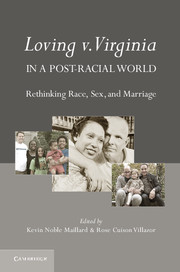Book contents
- Frontmatter
- Contents
- About the Contributors
- Acknowledgments
- Foreword
- Introduction Loving v. Virginia in a Post-Racial World
- Part One Explaining Loving v. Virginia
- Part Two Historical Antecedents to Loving
- Part Three Loving and Interracial Relationships: Contemporary Challenges
- Part Four Considering the Limits of Loving
- Part Five Loving Outside the U.S. Borders
- Part Six Loving and Beyond: Marriage, Intimacy, and Diverse Relationships
- 17 Black v. Gay?
- 18 Beyond the Loving Analogy
- 19 The End of Marriage
- Afterword
- Permission Granted
- Index
Afterword
Published online by Cambridge University Press: 05 July 2012
- Frontmatter
- Contents
- About the Contributors
- Acknowledgments
- Foreword
- Introduction Loving v. Virginia in a Post-Racial World
- Part One Explaining Loving v. Virginia
- Part Two Historical Antecedents to Loving
- Part Three Loving and Interracial Relationships: Contemporary Challenges
- Part Four Considering the Limits of Loving
- Part Five Loving Outside the U.S. Borders
- Part Six Loving and Beyond: Marriage, Intimacy, and Diverse Relationships
- 17 Black v. Gay?
- 18 Beyond the Loving Analogy
- 19 The End of Marriage
- Afterword
- Permission Granted
- Index
Summary
On June 12, 1967, when the U.S. Supreme Court handed down its unanimous ruling that statutes restricting interracial marriage could no longer be enforced, something happened. But exactly what? And how does it matter, whether for understanding (1) U.S. history before 1967, (2) the developments of the decades that followed, or (3) social or policy issues in contemporary America? Specialized scholars continue to address these questions, as the illuminating essays in this volume illustrate, and everyday citizens work within their own understandings, wishes, and concerns.
What, during the long history of the antimiscegenation regime, was understood as “interracial marriage” anyway? States freely defined the term, always differing from other states and often changing their own laws. If Mildred Jeter had been “Indian,” as she described herself on her marriage license, then she and Richard Loving could have married in Virginia – at least before 1924, before either of them were born. Even if she had African ancestry, the question would have been how much – until after 1924, when Virginia introduced the “one drop” rule to marriage. Her description of herself when she sought legal help as Mrs. Richard Loving in 1963 – as “part” Native American and “part” African American – had no legal significance under Virginia law at that time, which simply deemed her “colored.”
- Type
- Chapter
- Information
- Loving v. Virginia in a Post-Racial WorldRethinking Race, Sex, and Marriage, pp. 261 - 262Publisher: Cambridge University PressPrint publication year: 2012



